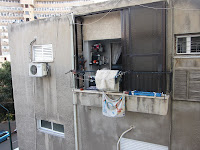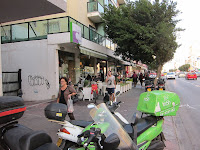I had a single. You can see the bathroom and shower through the door on the right.

The room was small, but efficient:

Each floor's hallway had a different design by a different artist:

The lobby had a 1970s feel to it:

The floor of each stairwell had a video installation. This is the one just off the lobby:

My first room, on the second floor, had no view. My parents had a double room on the south-east corner. I thought the neighboring building was a classic Tel-Aviv apartment:

When we stayed in the same hotel at the end of our trip, my room was on the fourth floor and I had views. Looking northeast:

Looking west towards the Mediterranean:

The breakfast buffet

Rochelle, dad, and mom at breakfast:

We spent a lot of time walking around Tel-Aviv.
Here's the dog park:

This is Mersand, a cafe where we often ate lunch:

Mom and dad on the tayelet, the promenade along Tel-Aviv's beach:

We also spent a lot of time on the street where dad grew up: Ben Yehuda
Here's the window of his old apartment:

Here's the door to his old apartment:

While in Tel-Aviv, we went to the Haganah Museum to talk to the archivist. We also toured the museum.
Here's part of the museum, the home of its founder, Eliyahu Golomb:

This chart shows the organization structure of the Haganah:

Here are places where the Haganah operated in the 1920s-40s:

Here's the oath and gun used to induct people into service:

This map shows where dad served, in Bet Keren Hakayemet L'yisra'el (aka Bet Dej'n):

Dad's childhood friend and army buddy, Aryeh, took us out to where they served, along the key road running from Jaffa to Ramallah.
Here's the sign to the former base (now just a monument):

Here's the monument, with dad and Aryeh:

Here's Aryeh and dad, where the bunkers used to be:

The only surviving structure is the well:

A few blocks away from their old base is the former British police station, outside of which dad was shot in an ambush:

On the road back to Tel-Aviv, we passed Mikve Yisra'el. This agricultural school was the first one established in Palestine in 1870. Graetz (the subject of my dissertation), toured in 1872 and praised its work.
The school:

The gate:

I very much enjoy the old buildings put up in the 1920s and 30s, which are finally being restored.
Here are some from Bialik Street:



Bialik's house:



The old city hall, and surrounding buildings



Ben Yehuda Street:



Other parts of Tel-Aviv:



Both dad and I love the Carmel Market.
This is the oldest gas station in Tel-Aviv (just behind the entrance to the market):

The market:










Near Carmel Market is the Nahalat Binyamin neighborhood, with its weekly crafts fair:







This is the former Berlitz School on Allenby Street. Dad remembers how in November 1947, they had loud speakers put up on the 2nd floor balcony, so the crowds could listen to the UN vote.

We also visited Jaffa and the flea market:
Mom and dad at Jaffa Harbor:




The Fishermen's Mosque:




The old city:



"Dr. Shakshura" (a restaurant in the flea market):

The Jaffa flea market:


The clock tower:

Finally, no trip to Tel-Aviv would be complete without spending some time at the beach.
Near the beach is this monument to illegal immigration to Palestine:

This is called a "hasakeh" (חסקה). Dad told us how he and his friends built one on the roof of an apartment.

Here's how it's used:









No comments:
Post a Comment